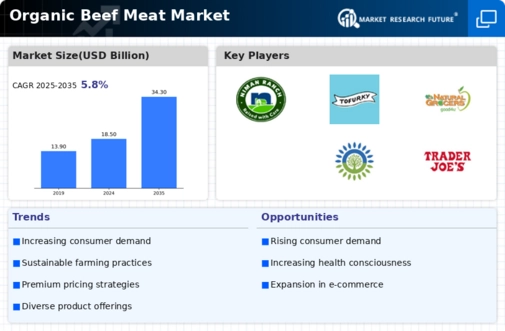Market Growth Projections
Rising Health Consciousness
The increasing awareness of health and wellness among consumers appears to drive demand for organic beef meat. As individuals become more discerning about their dietary choices, the preference for organic products, which are perceived as healthier alternatives, intensifies. This trend is particularly evident in the Global Organic Beef Meat Market Industry, where consumers seek meat that is free from antibiotics and hormones. The market is projected to reach 18.5 USD Billion in 2024, reflecting a growing inclination towards organic options. This shift in consumer behavior suggests that the organic beef segment may continue to expand as health consciousness prevails.
Consumer Demand for Transparency
The demand for transparency in food sourcing is reshaping the Global Organic Beef Meat Market Industry. Consumers increasingly seek information about the origins of their food, including the farming practices and conditions under which animals are raised. This trend towards transparency is driving brands to provide detailed information about their products, fostering trust and loyalty among consumers. As a result, organic beef producers who prioritize transparency may gain a competitive edge in the market. This shift in consumer expectations could further propel the growth of the organic beef sector, aligning with the overall trend towards more informed and conscious purchasing decisions.
Technological Advancements in Farming
Innovations in agricultural technology are transforming the landscape of the Global Organic Beef Meat Market Industry. Advances in breeding techniques, feed efficiency, and disease management are enabling organic beef producers to enhance productivity while adhering to organic standards. These technological improvements may lead to higher yields and better quality meat, appealing to a broader consumer base. As the industry embraces these advancements, the potential for growth becomes more pronounced. The integration of technology in organic farming practices could significantly influence market dynamics, positioning organic beef as a viable option for consumers seeking quality and sustainability.
Regulatory Support for Organic Farming
Government policies and regulations that promote organic farming are likely to bolster the Global Organic Beef Meat Market Industry. Various countries have implemented initiatives aimed at supporting organic agriculture, including subsidies and certification programs. These measures not only facilitate the transition to organic practices but also enhance consumer confidence in organic products. As regulatory frameworks evolve, they may encourage more farmers to adopt organic methods, thereby increasing the supply of organic beef. This regulatory support could play a crucial role in the market's growth trajectory, particularly as it is projected to experience a CAGR of 5.78% from 2025 to 2035.
Sustainability and Ethical Farming Practices
Sustainability concerns are increasingly influencing consumer purchasing decisions, particularly in the Global Organic Beef Meat Market Industry. As environmental issues gain prominence, consumers are more inclined to support farming practices that prioritize animal welfare and ecological balance. Organic beef production typically adheres to stricter regulations regarding land use and animal treatment, which resonates with ethically-minded consumers. This trend may contribute to the anticipated growth of the market, projected to reach 34.3 USD Billion by 2035. The emphasis on sustainable practices could potentially enhance the appeal of organic beef, positioning it favorably in a competitive marketplace.























